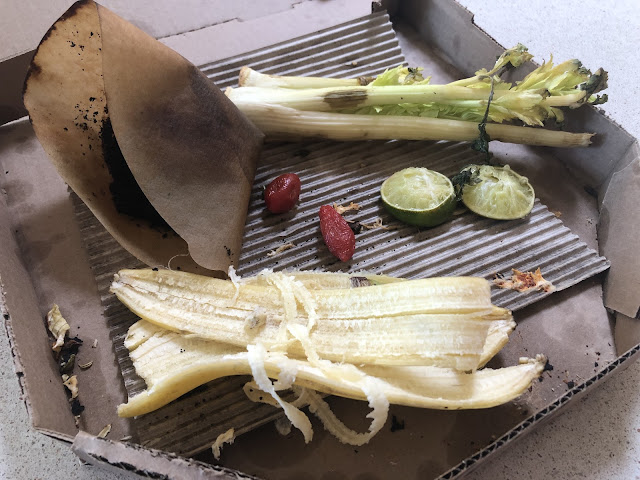
Organic waste program redirects food scraps into compost, not landfill

|
|
Starting Friday in Sacramento city and county, all these things -- including the used pizza box -- can be placed in the organic-waste container to be recycled into compost. (Photo: Kathy Morrison)
|
You will never look at a soiled pizza box or a banana peel the same way.
Friday is the start of Sacramento’s new organics recycling program. It’s part of a statewide rollout of new programs designed to cut down on organic waste – anything plant- or animal-based – in landfills.
Senate Bill 1383, which was signed by Gov. Jerry Brown more than five years ago, is finally kicking in. This state law mandates cities and counties to divert organic waste from landfills, where it breaks down into methane – among the worst greenhouse gases. Instead, the waste can be turned into compost to nourish soil or used to generate energy.
When it comes to climate change, methane is 80 times more potent that carbon dioxide. Food scraps alone represent up to 20% of all landfill material. According to CalRecycle, Californians throw away almost 6 million tons of food scraps each year.
How each municipality and county accomplishes that diversion of kitchen waste is up to them. And new rules vary in every county.
Customers are asked to keep their kitchen scraps (including meat, bones and leftover prepared food) separate from their household trash. Those scraps will then be collected weekly.
In Sacramento, the kitchen scraps are going into what used to be the “yard/green waste” container. That garbage can will now be referred to as the “organic waste container.” All the yard trimmings are still going into that container, too. And so will soiled food wrappers and other paper that can’t be recycled (such as pizza boxes); those items used to be confined to the trash.
The organic waste container will be used to dispose of kitchen scraps, green waste and food-soiled paper, says Sacramento. (That's the same in both city and county.)
Specifically, kitchen scraps include: Cooked and raw food waste, such as uneaten vegetables, fruits, trimmings, meats, dairy, bones, baked goods, eggshells, etc.
Green waste includes: Grass clippings, small branches, leaves, cut flowers, garden trimmings, wood chips, and clean wood (no paint, no stain, etc.).
Food-soiled paper includes: Used napkins, paper cups, coffee filters, greasy pizza boxes, tea bags, used (but uncoated) paper plates, etc.
As for paper, experts recommend placing several sheets of newsprint at the bottom of the organic waste container each week before filling. The newspaper can help absorb any liquids that may accumulate.
In addition, cover any additions of kitchen scraps to the container with a layer of dried leaves, grass clippings or more newspaper (preferably shredded). That will help keep down any fly or pest issues.
(Note: No pet waste is accepted in the organics bin, as well as such items as coated-paper milk cartons, glass or metal containers, or treated or painted wood.)
To get residents to start separating their organic waste, the city of Sacramento is offering a free 2-gallon food scraps pail. The covered pail can sit on the counter or go under the sink. To get yours, go to SacOrganics.org . County residents can find locations to get a free scraps pail here: SacGreenTeam.com
Since each county sets up its food waste recycling programs, residents of Placer, El Dorado or Yolo counties should contact their county waste management departments for procedures and pickup schedules.
Comments
0 comments have been posted.Sacramento Digs Gardening to your inbox.
Sites We Like
Garden Checklist for week of July 21
Your garden needs you!
* Keep your vegetable garden watered, mulched and weeded. Water before 8 a.m. to reduce the chance of fungal infection and to conserve moisture.
* Feed vegetable plants bone meal, rock phosphate or other fertilizers high in phosphate to stimulate more blooms and fruiting. (But wait until daily high temperatures drop out of the 100s.)
* Don’t let tomatoes wilt or dry out completely. Give tomatoes a deep watering two to three times a week.
* Harvest vegetables promptly to encourage plants to produce more. Squash especially tends to grow rapidly in hot weather. Keep an eye on zucchini.
* Pinch back chrysanthemums for bushy plants and more flowers in September.
* Remove spent flowers from roses, daylilies and other bloomers as they finish flowering.
* Pinch off blooms from basil so the plant will grow more leaves.
* Cut back lavender after flowering to promote a second bloom.
* It's not too late to add a splash of color. Plant petunias, snapdragons, zinnias and marigolds.
* From seed, plant corn, pumpkins, radishes, winter squash and sunflowers.